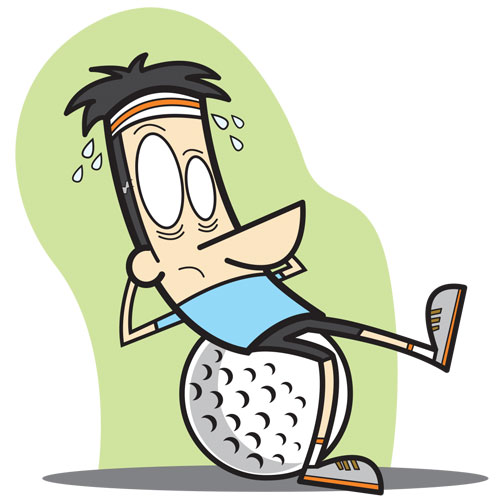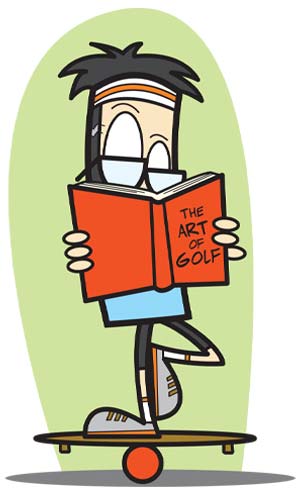2025 Colorado Getaways: Steamboat Springs
Steamboat Springs is like a secret only you and your friends know

By Neil Wolkodoff, Ph.D, illustrations by Dave Palmer
MOST SENIOR GOLFERS don’t think about how aging affects their game until aches, pains and loss of distance begin to encroach.
Your chronological age is your age in years, and your functional age is how you function. The two can be completely different. Some 73-year-old golfers function at strength, power and endurance levels of those who are 47. Conversely, a sedentary 47-year-old can have the functionality of an average septuagenarian.
Unfortunately, just continuing to do the same routine you did at age 24 does not respect the critical changes to the body as it ages. While not a total list, here are some of the research and application concepts to playing better golf, gaining health and function and being more vital if you are over 50.
RESPECT STRUCTURE
After 50, your joints show signs of wear and have less structural support.
For the shoulders, the ligaments around the rotator cuff lose density, making injuries more likely. Twice per week, take five to nine minutes and perform a rotator-cuff program with elastic bands.
Knees have less support and cushioning after 50 just from wear, so minimize impact activities like running in favor of cycling and the elliptical.
Your feet lose support in the arch, which tends to fall with increasing age. The fat pads under the ball of the foot and heel also wear out, diminishing your ability to take even the typical impact of walking. The simple solution is properly fit orthotics combined with more traditional golf shoes offering increased lateral and heel support compared to minimalist/athletic styles. And remember to change your golf and athletic footwear yearly if not sooner, as they lose their lateral support and cushioning sooner than you think.
WORK AND MOVE
Sitting at a desk slows metabolism, leads to swollen legs and encourages poor posture. The first goal is to sit less. Getting up once per hour and taking a three-minute walk will lessen fluids settling in the legs and elevate metabolism. If you can, sit on a FitBall at work instead of an office chair. Or opt for an adjustable standing desk.
After looking down at the computer most of the day, our shoulders round, affecting our spines. Every time you hit “save” on your keyboard, stand up straight and pull your shoulders back.
THE CORE PROBLEM

The reasons golfers over 50 lose distance are lack of a consistent and optimal golf posture and the ability to rotate around a stable spinal angle. This all literally pivots around your core.
With the core, simple is better, so use a FitBall every day for three to five minutes to train the core and work on total body flexibility. Because the FitBall is mildly unstable, it activates the deep muscles in the core as they are righting muscles, or muscles that keep you from falling.
Short bursts of 10-15 repetitions are very effective at engaging these muscles. They are endurance muscles, and if you could ask them, they would prefer limited repetition sets with just body weight in various positions. Additionally, the FitBall offers some unique ways to stretch the whole body rotationally in a short time.
LESS PLASTICITY, MORE CONSISTENCY
Every decade above the age of 30, it takes 10 percent more time to make a training gain and 10 percent more time to recover. Plan your exercise carefully with scheduled breaks to recover. For example, exercise Monday, Tuesday and Wednesday, take off Thursday, exercise again Friday and Saturday, and rest Sunday. Also, only lift weights twice per week, and give yourself at least two days in between for recovery.
TRAIN FOR GOLF, DON’T USE GOLF TO TRAIN
Under the age of 30, sports provide a training or fitness benefit because of body plasticity and intensity level. After the age of 50, sports don’t give the same fitness benefit. Surprisingly, many studies suggest that even competitive cycling will not build and maintain leg strength or muscle mass for those over 50.

To play effective golf you will have to build your endurance, sprint capacity (you won’t get the physiological yips approaching the putting green or tee box) and strength outside of golf. Start with small doses like 20 minutes of exercise for each session, then work up to 59 minutes per day, five days per week—the threshold that indicates you’re doing enough formal exercise to affect weight, health and performance.
People over 50 tend to be more sedentary, so formal training is even more critical. Overall, those five days should typically be comprised of two resistance training days and three days spent in endurance-building exercises, like cycling.
OPTIMAL MUSCLE/BODY COMPOSITION
To determine ideal weight, throw out BMI and use body composition, or the ratio between optimal body fat and the good tissue, like muscle and bone. Getting a measurement of segmental body composition (arms vs. legs vs. trunk) is key to determining if you are maintaining muscle in each area and what is a healthy weight.
For men, less than 20 percent body fat is healthy; for women, less than 28 percent is ideal. Body-fat percentage tends to rise with age because of the average loss of muscle mass, specifically in the “fast-twitch” or explosive muscle fiber. This leads to decreased metabolism, resulting in fat and weight gain.
Thirty years’ worth of data indicates that resistance training at the highest level at which you can perform ten repetitions can restore some degree of muscle mass and strength.
For the senior golfer, those strength-building and muscle-maintaining exercises should comprise 80 percent of resistance training. Only 20 percent should focus on “functional” exercises that might help with golf.
As pro athletes know, without fundamental strength, functional exercises are of minimal value. While you don’t need to lift heavy weights all the time, most senior golfers tend not to push enough resistance to maintain muscle mass and strength.
RECOVERY BOOST

After you turn 50, there are days where you need either complete rest or just light exercise. Recovery is now a science. If you have to exercise the day following strenuous exercise or hitting a lot of golf balls, try riding a recumbent bike at a light level for 30 minutes. This will allow recovery activity without further stressing the back from resistance training or golf. Massages do help, and if pressed for time in your weekly schedule, consider a massage chair at home where you can go head to toe in 15 minutes.
FOOD, ENERGY AND SUPPLEMENTS
When you are 25, your metabolism is a blast furnace. Hit 50, and you are a smoker grill. The key is to match consistent caloric intake to your needs.
Once you’ve established your golf and exercise schedule, calculate your resting metabolic rate (basically the energy required by your body to perform the most basic functions—breathing, circulating blood, thinking—when at rest) at 10 calories (kcal) for every pound. A 6-foot tall, 170-pound man’s resting metabolic rate would be 1,700 calories per day. To that number, add energy nutrition to maintain a balance. For an average work day, add 200 kcal, 900 for golf in a cart, 1400 for walking/carry golf and 500 kcal for each hour of formal exercise.
With fluids and water, an excellent place to start is half your body weight in ounces per day, more due to perspiration.
Remember, if you’re over 50, you’re likely taking 4-7 regular medications for such conditions as blood pressure, anxiety and cholesterol. With your physician or trained health provider, work on supplements that might help specific conditions like inflammation without interfering with the medications. Be very careful. Many of these medications don’t play well with herbal supplements, so a professional opinion is the wisest road before implementation.

THE EYES HAVE IT
While everyone knows to protect their skin from the carcinogenic sun, your eyes need both nutritional support and protection. In addition to providing protection from harmful rays, many sunglasses now offer enhanced optics for reading greens and seeing course detail. Research has proven eye supplements like lutein and zeaxanthin improve eye function and diminish greatly the progression of macular degeneration.
HAND-EYE-FOOT-BRAIN
Other overlooked culprits in the diminution of golf skills after 50 are the losses of coordination and sensory processing. Formal sensory and brain training is the most effective route because you train something specific such as reaction time combined with balance or speed of recognition.
A home strategy is to get a rocker/balance board and practice going from front to back, then side to side each day for 30-45 seconds with your feet in different positions while moving your arms in different ways.
Keep the brain going by taking alternate routes to regular destinations, reading something challenging every day and playing games like chess, Sudoku or Word Collect.
Neil Wolkodoff, Ph.D., ([email protected]; 303-596-6519) is the medical program director for the Colorado Center for Health & Sport Science, a medical fitness facility in Denver. At CCHSS, he works with patients ranging from senior exercisers to professional athletes who seek to link fitness, improved function and better health.
This article appeared in the 2019 May Issue of Colorado AvidGolfer
Colorado AvidGolfer Magazine is the state’s leading resource for golf and the lifestyle that surrounds it, publishing eight issues annually and proudly delivering daily content via coloradoavidgolfer.com.
Steamboat Springs is like a secret only you and your friends know
Vail Valley is home to an endless array of summer outdoor pursuits